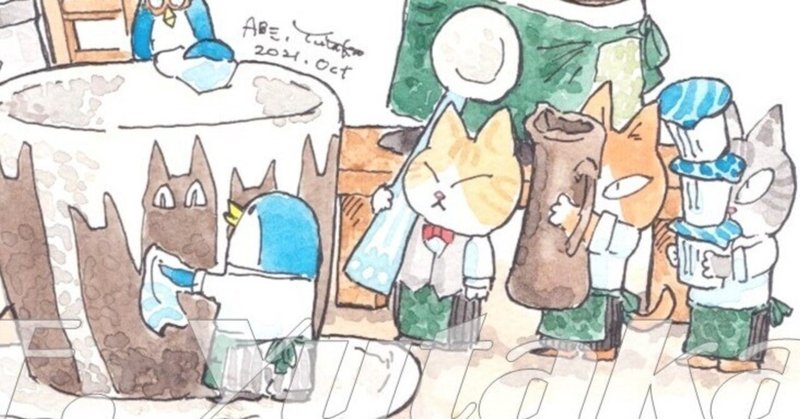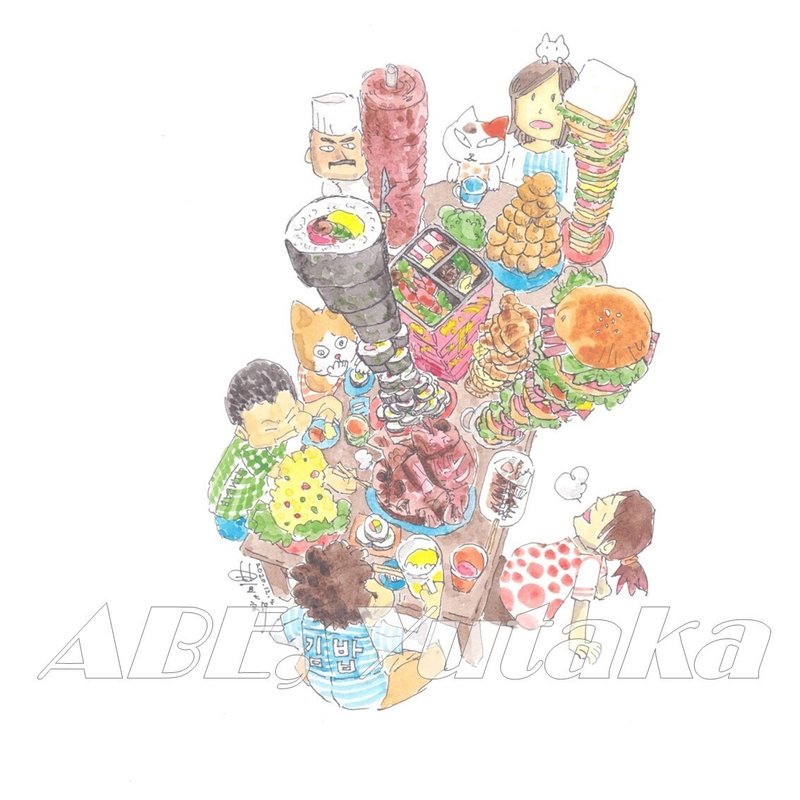
Illustration in Exhibition, Nov 2021 prat2 展示会11月作品②
イラスト説明が長い理由(再掲) The reason why explanations of the background and highlights of the illustration are long
At the exhibition, I also focused on explanations. In the case of museums, there are cases where the feeling of a artist is not shown. Why he/she wanted to draw this, what he/she wanted to tell to us… In the case of my illustration, I thought it would be more interesting to tell a story, so I wrote a long explanation of the background and highlights of the illustration.
Here, I will introduce a part of the explanation and illustrations.
(再掲) 展示会では説明文にも力を入れました。美術館とかだと作者がどういう状況で、なにを描きたかったのか、全く知らせていない場合や堅苦しく説明してい場合がありますね。私のイラストの場合は、ネタバラシをしちゃった方が面白いなと思って、長々とイラストの経緯や見どころの説明を書きました。ここでは、説明の一部とイラストを紹介します。
ネコ バリスタ barista Cats

It is a work imagined the making coffee dripping process of master of "Cafe Shippona" where the exhibition were held.
You can see how she concentrated on dripping coffee when you sits at the counter. She is too focused on the work that you cannot talk to her. That's why she can make delicious coffee.
My favorites in this illustration are the three cats who are standing upright with a spoon or syrup. Due to the ecology of cats, the cats that appear in my illustrations are often laid back or relaxed. But this time, it would be interesting to draw that they are working hard.
展示館でお世話になった「しっぽな」のマスターがコーヒーを入れる作業を、なんとなくイメージをしながら描いた作品です。
カウンター席に座るとよくわかるのですが、コーヒーを入れる時の彼女の集中力たるや、とても話しかけられるようなものではありません。全集中水の呼吸でコーヒーを淹れてくださいます。だから美味しいコーヒーができるのかな思っています。
このイラストのお気に入りは、スプーンやシロップなどを持って頑張って立つピシッと立っているネコちゃん達3人です。猫の生態上、私のイラストに出てくるネコたちものんびりしていたり、ダラダラしていたりすることが多いのですが、今回はビシッと仕事をしているところを、描いてみたら面白いかなと思いました。たまにはいいでしょう。
キンパパーティー Gimbap party

I was invited to a Korean friend's house, which I have been friends with since I was a University student, and treated me to Gimbap.
Gimbap is a Korean seaweed roll. I was surprised that the gimbap was delicious and I could eat as much as I wanted. However, ginbap was not only delicious but also visually enjoyable. The gimbap cut into 2⁻3 cm heat was arranged like a tower, and an idea to drawing such a tower had come into my mind. In the end, I added sandwiches, hamburgers, kebabs, and tower rice from around the world.
By the way, I like drawing tower rice. Please let me know if you have any ideas.
学生の頃から仲良くしている韓国の友達の家に招かれてキンパをご馳走してくれました。
キンパは韓国の海苔巻きです。キンパが美味しくて、いくらでも食べられることにビックリしました。しかし、美味しいだけでなくビジュアルでも楽しかったのですよ。2-3cmの暑さに切ったキンパを重ねてがタワーのように盛り付けていることに面白さを感じて、このようなタワーの食事を描いたらとアイディアが膨らみました。最終的には、サンドイッチだったりハンバーガーだったりケバブだったり、世界のタワー飯を加えて描いてみました。
そういえばタワー飯を描くのは好きですね。何かアイディアがあったら教えてください。
狭い場所での読書 Reading in a small space

This illustration has a clear motif. In the TV commercial of the house maker, father (the famous actor Yutaka Takenouchi) was pleased with the high ceiling with his family, but he actually liked the small space. Then photos that he was reading a book under the desk with nice smile when he was young. I don't like small spaces, so I got a fresh feeling that there are people like that kind of feeling. I've been kept this idea in my mind for a long time. There are many inspirations from one scene of a TV commercial.
The wood used for the desk is glued laminated lumber. Wood is often seen in lumber processing methods such as solid lumber, glued laminated lumber, and plywood. I love wood grain and knots so much that I like solid wood cut from a single piece of lumber. However, solid wood furniture is quite expensive, so I tend to go to glued laminated lumber. It's a good idea to think of it as a collection of solid wood. This time, I drew a desk using glued laminated lumber realistically even in the illustration world which we can do everything you want. I do not know why.
この作品には、明確にモチーフと言うかパクった元があります。ハウスメーカーのCMで竹野内豊さんが高い天井に喜びつつも、実は狭い場所が好きって言うのがあって、その中に出てくる若い頃の竹野内豊さんが机の下で読書をしている写真です。私自身、狭いところは嫌いなので、そういうネコみたいな人もいるんだなぁと新鮮な感覚を受けたのと同時に、イラストのアイディアとして長らく私の頭の中で寝かしてありました。モチーフなので、このイラストの人物は、全く竹野内豊さんとは似ても似つかなくてよいのです。このようにCMのワンシーンから着想を得ることは多くありますね。
余談
イラストの机に使われている木材は、集成材です。木材は製材加工の仕方でよく見るものとして、無垢(むく)材、集成材、合板などがあります。私は、木目や節などがすごく大好きなので、一本の材木から切り取られた無垢材が好きです。しかし、無垢材の家具はかなりお高めなので、集成材に行きがちですね。集成材は、断面寸法の小さい木材を接着剤でくっつけて作られる木材で、木目や節などは時々見当たりますので、まあ無垢材の集合だと思えばいい感じです。ちなみに、合板は薄くスライスしたベニヤ板と繊維方向が直交するように層状に接着したものです。木目も出ることはありますが、やはりちょっと木目の美しさという点では集成材や無垢材に劣るところがあります。今回はイラストという何でもありの世界でも、現実的に集成材を使って机を書いてみました。
水循環システム vers.1 Water cycle system vers.1

This illustration was drawn in 2009 when I was a student of Ph.D. My specialty is hydrology (a field of earth science that studies the movement, quality, and circulation of water on land), and I was researching how groundwater flows in semi-arid areas of China. So I wanted to draw something about the water cycle in the illustration.
It is difficult to express the underground, so I cut cross-sections so that the water movement can be seen, and made a slightly mysterious picture. The lower left is a septic tank, and cleaned water goes out to the fountain on the upper right.
The motif of this illustration is myself who had tried to construct a river, a pond or a well in my parents' garden. What was realized was a pond about the size of a bath. Today, the real bathtub is fitted in. It's an illustration that contains an unfulfilled dream that I can't make it.
このイラストは2009年のものですから、私が博士号をとるための研究をしていた時の作品になります。私の専門分野が水文学(すいもんがく;地学の一分野で、海以外の陸にある水の動きや質、循環について研究する学問)で、中国の半乾燥地で地下水がどのように流れているのかを研究していたので、何か水循環に関することをイラストに描きたかったのだと思います。
地下のことは表現するのが難しいので、断面を切ってみて水の動きが見えるようにして、ちょっと不思議な絵にしてみました。下に左下にあるのは浄化槽になっていて、ここを通ることによって水がきれいにされて、右上の噴水に出ていく構造になっています。
この絵のモチーフは、実は私自身で、このころ実家の庭に川を流したり、井戸を掘ったりしてみたいという想いがありました。実現したのは、お風呂ぐらいの大きさの池でした。現在は、リフォームの際に出た本物の浴槽がはめ込まれて、池としては残っています。本当はイラストのような流れを作りたかったんだけど、とても作れないという叶わない夢が入っているイラストです。
対照流域法を用いた直接流出と基底流出の観測 Observation of direct and basal flows using the paired watershed method

Until the end of 2020, I was working at the Kanagawa Prefecture Nature Conservation Center, where I participated in a water cycle research project aimed at conservation for the water recharge function of the forest that was devastated by the lack of maintenance in the Tanzawa Mountains.
To clarify the impact of forest maintenance on the water cycle of mountains, the "paired-watershed method" was used. The amount of river water coming out of two paired-watersheds under similar conditions (area, geology, vegetation) was measured in chronological order (for example, every hour and every day). This is a survey to compare how the river flows change by giving an impact such as forest maintenance to the other while keeping one basin as it is. It may be easy to imagine the comparison between a bored watershed and a forested watershed. It is common to compare this before and after forest maintenance, and it is difficult to continue measurement and research for many years. Why do we have to work a hard time comparing the two basins? That is because the natural environment is not uniform. It will never same rain again. Even if it fell the same 10 mm in one hour, it may have continued to fall for one hour, or it may have fallen in three minutes. The dryness of the trees and the ground surface (soil) that the rain first comes into contact with also differs between the day when it rained the day before and the day when it had no rain for a month. There are various paths until dropped rains appear on the river, so it is no exaggeration to say that the day with the same conditions will never come again. Therefore, it is the method that aims to "match as much as possible" the non-uniform natural conditions by measuring in two similar basins at the same time.
In the illustration, a gay made raining artificially. Some rain infiltrates the soil layer, flows slowly, and finally flows out of the tunnel under the beaker. On the other hand, the water flowing out from the edge of the beaker is the river water (surface flow) that flows out as soon as it rains. We set the flow weir underneath the beaker to measure the flow rate.
This illustration compares a devastated planted forest (left side) with a mixed forest with forest maintenance (right side). In fact, the most important roles of the forest problem is Mr. Panda.
In the current Japanese forest, there are many places where artificial forests of sugi and cypress are not thinned like the beaker on the left, and even if they are thinned, they cannot be carried out the timbers and are left them on the forest floor. This is because forestry is not running as an economy. This has a great impact on the water cycle and sediment runoff. Specifically, it has been pointed out that in degraded forests, there is little infiltration when it rains, and there is a large amount of direct runoff from the beaker's edge, increasing the risk of flooding. (However, this is also a difficult point in the natural sciences, even in degraded forests, the water cycle may not be affected so much. Nature is not absolute). Returning to the story, if you don't take the wood out of the forest and use it, the forest will end up in a rough state, so Mr. Panda's role is very important.
2020年度末まで神奈川県自然環境保全センターというところで働いていて、そこでは丹沢山地の手入れ不足で荒廃した森林の水源としての機能を復活させ、しっかりと保全することを目的とした水循環研究プロジェクトに参画をしていました。
森林整備が山の水循環に与える影響を明らかにする調査手法として、「対照流域法」を使っていました。対照流域法は同じような条件(面積、地質、植生)の隣り合った2つの流域(集水域)から出てくる河川水の量を時系列(例えば1時間ごと1日ごと)で測って、片方の流域はそのままに、片方に森林整備などインパクトを与えて、河川流量がどのように変わるかを比較する調査です。わかりやすいのはハゲ山と森林の比較ですかね。これをビフォーアフターで比較するのが一般的で、何年も長期間にわたって調査・研究を続けるのは大変です。なぜ大変な思いをして2つの流域を比較するのか?それは、自然環境は一様ではないからです。雨は二度と同じように降りません。1時間に同じ10mm降ったとしても、1時間しとしとと降り続けたか、3分でドバっと降ったのかもしれない。雨が最初に接触する木々や地表面(土壌)の乾燥状態も、前日に雨が降っていた日と、1か月雨がなかった日では異なります。他にも雨が降って河川に出るまで様々な道があるので、その条件が揃った日は二度と来ないといっても過言ではありません。そのため、同じような2流域で同時期に測ることで、一様でない自然条件を「なるべく揃える」ことを目指した涙ぐましい調査方法なのです。こういう研究をしていると「60年間住んでるけど、こんな雨は初めて」とニュースで流れる気候変動を匂わせる報道に「そらそうだろ」とツッコミたくなります。
イラストでは雨を人工的に降らせちゃっていますね。降った雨の一部は地層に浸透してゆっくり流れて、ビーカーの下のトンネルから流れ出てきます。対して、ビーカーの淵から流れ出ている水は雨が降った途端に流出する河川水(地表流)で、下で水を受けているのは流量堰というもので、これで流量を時間的に連続して、正確に測ることができます。
このイラストは荒廃した人工林(左側)と森林整備による針広混交林(右側)の比較をしています。実は森林問題で一番重要なのが、パンダさんの役割なのです。
現在の日本の森林は、左のビーカーのようにスギやヒノキの人工林が間伐されないままで、間伐されても搬出することができないで放置されている場所が多く点在します。林業が経済として回っていないためです。これが水循環や土砂流出に多大な影響を与えます。具体的には、荒廃森林では雨が降った時の浸透が少なくて、ビーカーの淵から落ちる直接の流出量が多いことが指摘され、洪水のリスクを増大させていると指摘されています。(ただし、これも自然科学の難しいところで、荒廃森林でも水循環にはあまり影響がないということもありますが。自然は絶対じゃないんですよね)。話が戻りますが、まだ山から木材を持ち出して使わないと、結局は森林が荒れた状態になってしまいますので、パンダさんの役割は大変重要なのです。
